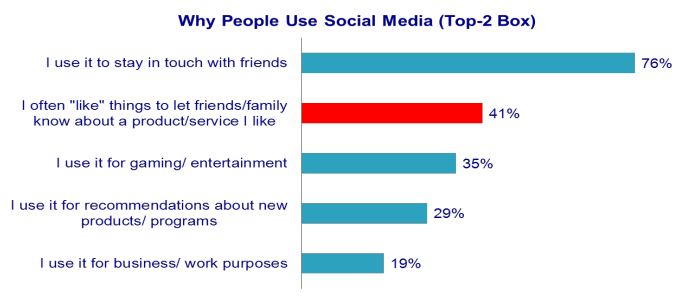Does the book cover the 80/20 rule ?
Yes the book does cover the 80/20 rule. The book covers the 80/20 rule because it covers and focuses on the main argument through majority of the book.
Yes the book does cover the 80/20 rule. The book covers the 80/20 rule because it covers and focuses on the main argument through majority of the book.
This graph shows that without social media, it would be harder to stay connected with friends, or let family members know what you like.

Our personal thoughts/opinions on this book are that we thought it expanded our thinking because it made us think and see how the Internet, video games, and movies were good for us. We also thought the book really went into depth and gave strong reasons of why the media benefits to us by actually making us intellingent. Something that really stood out to us in the book is when Johnson talked about the Flynn Effect, which is where he talks about how the IQ scores went up because of the complex media. We felt the book was useful to us because we got to know why the media is good for you and not bad like others say it is. Victoria and I think that we would recommend the book to others because we thought others would be interested to learn or get to know how video games and the Internet are good for you.
The book "Everything Bad Is Good For You," by Steven Johnson argues that video games, televison, film, and the Internet are good for us. In the book he states that those things are good for us because video games and the Internet have grown more complex over the past years. Steven Johnson states in the book that while playing video games it can help you learn critical thinking skills. As for the Internet Johnson also says that it forces users to probe and master new environments. From what Johnson is saying he introduces the Sleeper Curve. The Sleeper Curve shows the benifits of what the more complex media has done to us. Johnson separates the book into two parts. In the first part he states that the Internet, video games, and film have grown more complex. In addition, the second part shows the similarities of the entertainment and how it increases intelligence. In the book Johnson introduces the Flynn Effect. The Flynn Effect shows that the IQ scores rose because of the popular culture. This means because we're playing more complex games, television shows, and movies our IQ scores are going up.
In the book "Everything bad Is Good For You" Steven johnson does have a clear organized argument. Johnson argues that video games, television shows, or movies aren't as bad as people say it is because it actually makes people more intelligent. The book is organized by first explaining to the readers about the sleeper curve and splitting the book into two parts. The first part in the book talks about the benifits of how games, televison, and the internet are more complex and make you intelligent. The second half talks about the Flynn Effect and how technology applys to the Sleeper Curve. Also how "technology trains the mind to explore and master complex systems", found in the book on page 176. The argument is presented through the text by using anecdotes and facts of how technology is good for you.